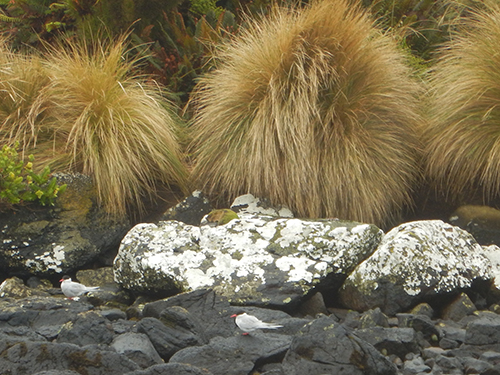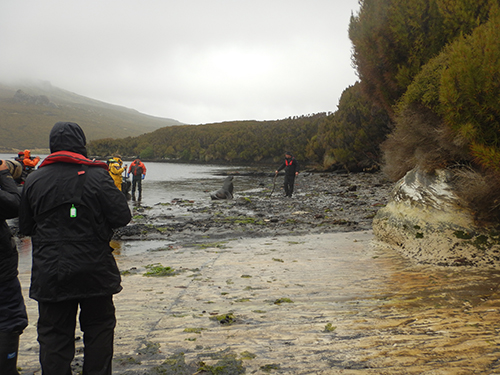31/12/15
6AM Perseverance Harbor, Campbell Island We anchored in Perseverance Harbor at 1AM on this morning, just as a cold front came through. Cutting wind slices sharp off volcanic hills, sleety droplets pecking through the mist. Perseverance Harbor’s narrow entrance is behind the ship, opening out on the eastern side of the island. The harbor almost cuts the island in two, running east-west through the old volcanic caldera. Like the Auckland Islands, Campbell’s western coast is eroded into steep cliffs and rock stacks. To the north, south and west of the harbor rise abrupt hills covered in thick vegetation, topped with rocky outcrops. Apparently the sun will come out later today after the cold front passes. Unlike the Auckland Islands or Macquarie, I don’t see or hear any wildlife at first glance. Lowering fog makes it difficult to see what type of plant life is there but we’re assured we’ll see plenty of bright megaherbs, albatross and more Hookers sea lions by dinner. A cluster of old huts line the shore, a reminder of Campbell Island’s history as a sheep station, weather outpost and war- time coastwatchers refuge.

First view of Campbell Island, looking west to the harbours head with Beeman Cove’s huts at right

Looking east, behind the ship to the harbours mouth
Today there’s 2 options – a 12km trek across the island to North West Harbor, or a morning zodiac cruise searching for Campbell Island Teal followed by an afternoon trek up a boardwalk to the Col Lyall saddle, an 8km round trip through megaherb fields. Col and Lyall are two of the islands peaks, and although I can’t make them out through the mist I’m looking forward to the hike after a morning teal hunt.

Weather station huts at Beeman Hill
9AM The harbor is so calm, barely a ripple. Low, shallow shoreline, dracophyllum and tussock scrub dotted with bright Bulbinella ease right down to the waterline, a thin band of rocks mark the tide. Our zodiacs putter around the shores, looking for teal. A small, flightless duck, the Campbell Island Flightless Teal was thought to have been wiped out by Norway Rats that infested the island from the early sealing days. It was rediscovered by our expedition leader Rodney Russ in 1975 on Dent Is, one of the small, steep islets dotting the coast. The last few birds were captured and a successful breeding program saw them re-introduced in the 1990’s. With the island rat free since 2005 the teal and other wildlife are flourishing.

The search begins
We saw 5 teal this morning including a pair, the male with an iridescent green head. They’re funny little birds, dabbling in kelp and rocks on the shoreline then flapping and splashing up into the scrub when our ever-clicking cameras converge, only to trot back down to the waterline a few feet away. Rodney told us all about the teal with an insider’s insider’s knowledge, and we even saw one with a leg band showing it was part of the initial re- population of the island – must be a hardy little duck!
In the short video below by fellow expeditioner Archie Paton you can see a pair of teal foraging on the shoreline
The clicking and whirring sounds in the video are two dozen cameras snapping candid teal moments.

We found teal!
Antarctic terns and Campbell Island Shag perch on limpet-crusted rocks, kelp gulls swooping and feeding. The water is so clear I can see the bottom meters down but it’s still a surprise when sea lions surface, blowing and huffing. One circles our zodiac, keeping an eye on the interlopers in her patch.

Campbell Island Shag

Antarctic terns dwarfed by tussocks

Sea lion tour guide
Campbell Island has a chequered history of human habitation, and we visit some of the key sites. Frederick Hasselborough named it after his employer, the Campbell and Co shipping company on its discovery in 1810. He drowned in Perseverance Harbor (named after his ship) on another voyage 10 years later along with two others: a woman named Elizabeth Farr and George Allwright, a young boy working on the ship. Elizabeth Farr was buried in Garden Cove, but the bodies of Captain Hasselborough and George Allwright were never recovered. A gently sloping inlet in a quiet corner of the harbor, parts of Garden Cove were used in later visits and settlement attempts to grow food but like on the Auckland Islands, acidic peaty soils defied cultivation. Sealing and whaling were pursued sporadically at Campbell Island up until the 1920’s, but rarely turned large profits. This was likely due to the depletion of seals and whales by the heavy exploitation of the previous 110 years.

View into Garden Cove
We stop at another spot with a tragic past, an inlet where, the story goes, a woman was left by a sealing brig in the early 1800s. Some accounts have it that she was linked to the Jacobite uprising in England, but likely the story is based on the drowning of Elizabeth Farr in 1820. It’s also possible there was a different woman, captured or coerced onto a sealing brig then put ashore – abandoned – at Campbell. A small hut was apparently found at the site years later. She must have suffered a cold, lonely fate.

New Zealand Flax stands out among the tussocks and dracophyllum at Tucker Cove
A short distance from this sad site in Tucker Cove a stand of flax, not native to the island, still marks the site of another hut. In the 1890s to 1930s shepherds were installed to manage sheep runs auctioned off on the island by the NZ government. A grassy sward boasts a cast iron stove, all that remains of the shepherds hut built and inhabited by Shetland Islanders employed to manage the sheep runs. The last sheep were removed from Campbell in the 1970’s, feral descendants of earlier flocks. Brick ends on the shore, a sturdy glass bottle and seedlings sprouting in the sole of a leather shoe final mementos of another failed enterprise in the Subantarctic.

A testament to traditional ironwork

Serried ranks of dracophyllum, dark ferns and thick tussock lead into green grasses spiked by yellow Bulbinella flowers

Brickends and an old bottle on the shore

Remnant dock and slipway close to shepherds hut site
Further around the harbor in Camp Cove we come to the ‘Loneliest Tree in the World’, a spruce pine planted by NZ Governor General Lord Ranfurly in 1901, during the time of the sheep runs. Although it’s an introduced species this tree is now World Heritage listed. The only large woody plant growing so far south, the spruce stands 5 meters tall against perpetual salt laden westerlies sweeping down Campbell’s steep slopes.

Summer visitors to the lonely tree.
In a rivulet running from this lonely tree I find some intriguing evidence of the islands volcanic past. Chunks of chert, a type of volcanic glass, litter the stream. Translucent grey green in the center, coated in a yellowing opaque shell. Looks like big sticks of rock candy. Katja has told us how every volcano on earth produces a unique type of volcanic glass, and these are Campbell’s signature geology.

Campbell Island chert
Heading back to the zodiacs the path is guarded by a feisty sea lion – is it the same one that was tailing us? Lucky we have experienced guides to recall the protocol – just keep walking, don’t run, get in the zodiac. As we pull away from the shore the sea lion keeps pace, undulating around us and popping up unexpectedly to make sure we’re staying in line.

Form an orderly line…
Taking the long way back to the ship we pass Venus Cove, another grave site. In 1874 a French scientific expedition came to Campbell to observe the transit of Venus and record the Subantarctic environment. One of their number died at Campbell, and is buried near Venus Cove. Many of the early commercial expeditions to the Subantarctic kept their activities and records secret from their competitors, and there are accounts of graves with no known links to documented expeditions. In an environment so brimming with life, it’s a sobering reminder of the harsh reality here. On the way back to the ship flocks of kelp gulls swoop and call. We watch one gull dive down, snatch a mussel then rise up to drop it neatly on the rocky shore, cracking open a juicy morsel.

Venus Cove

Kelp gull and mussel

Camp Cove send off

Spot the terns

Flock of Campbell Island Shag sheltering under flowering Hebe elliptica
